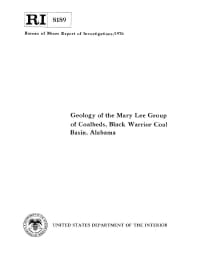Mining Publication: Geology of the Mary Lee Group of Coalbeds, Black Warrior Coal Basin, Alabama
Original creation date: January 1976
Authors: GW Murrie, WP Diamond, SW Lambert
NIOSHTIC2 Number: 10000629
Pittsburgh, PA: U.S. Department of the Interior, Bureau of Mines, RI 8189, 1976 Jan; :1-49
A geologic study of the Mary Lee Group of coalbeds in the Black Warrior Coal Basin was undertaken to examine coal stratigraphy and determine regional trends and extent of the coalbeds. The area investigated encompasses 835 square miles in Jefferson, Walker, and Tuscaloosa Counties, Alabama. More than 700 core logs were used to construct a structure map, coal, interval, and overburden isopachs, and cross sections. There is evidence that structure affected sedimentation. Coalbed isopachs indicate the Mary Lee group was deposited in fluvial-deltaic and low-lying coastal plain environments. The Mary Lee coalbed is the only coalbed which is continuous throughout the area, commonly with two benches which have a combined thickness of 2 to 12 feet. The Mary Lee coalbed changes rank in the basin from high-through medium- to low-volatile coal. The methane gas potential of the Mary Lee Group coals is estimated to be greater than 1 trillion cubic feet. There is an excellent correlation between the orientation of surface cleats with those measured underground in the Mary Lee coalbed. The face cleats roughly parallel the axes of the folds of the area and trend northeast- southwest.

NIOSHTIC2 Number: 10000629
Pittsburgh, PA: U.S. Department of the Interior, Bureau of Mines, RI 8189, 1976 Jan; :1-49
- Degasification of the Mary Lee Coalbed, Brookwood, Ala
- Improved Methods for Monitoring Production From Vertical Degasification Wells
- Integration of Vertical and In-Seam Horizontal Well Production Analyses with Stochastic Geostatistical Algorithms to Estimate Pre-Mining Methane Drainage Efficiency from Coal Seams: Blue Creek Seam, Alabama
- Methane Gas Content of the Mary Lee Group of Coalbeds, Jefferson, Tuscaloosa, and Walker Counties, Ala.
- Time-Lapse Analysis of Methane Quantity in the Mary Lee Group of Coal Seams Using Filter-Based Multiple-Point Geostatistical Simulation